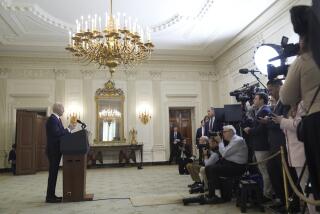Chinese Language : Newspaper Wars--the Battles Rage
At the approach of midnight in Taiwan, a transmitter at the Taipei branch of the Chinese Daily News flashes a single facsimile page to the newspaper’s Monterey Park office, where it is quickly incorporated into an edition that hits the streets of Chinatown in time for the lunch crowd.
This late-morning edition, carrying news that readers in Taiwan have yet to see, is an important plus for the paper in its fierce competition with two other major Chinese-language dailies published in the United States--the International Daily News and the Centre Daily News.
The three papers--which all run major Southland operations out of offices along a three-block stretch of Monterey Pass Road in Monterey Park--are engaged in a free-for-all reminiscent of bygone days in American journalism when newspapers divided along fiercely partisan lines.
Rapid Growth
Since 1980, the number of Chinese-language newspapers published in Los Angeles has grown from two weeklies to about a dozen dailies and weeklies.
Technology such as satellite transmission of page facsimiles brings a Space Age touch to the major Chinese-language dailies’ competition, while China’s unfinished civil war infuses it with political intrigue.
The seriousness of the business--and the risks involved--is illustrated by the recent arrest in Taiwan of the publisher of the International Daily News, Lee Ya-ping, on charges of printing and distributing Communist Chinese propaganda. A Taiwan citizen with immigrant status in the United States who maintains a San Marino residence, Lee was released late last month on a form of probation after protests from the U.S. State Department.
Useful to Immigrants
For tens of thousands of Chinese immigrants in Los Angeles and throughout the United States, these papers provide vital information about American society, national politics and world events. They are central to the life of Chinese communities in the United States and serve as important weapons in the political rivalry between Taipei and Peking.
Many editors also believe that by providing information that contributes to assimilation, their newspapers serve as important bridges between the newcomers and established communities.
“We tell our readers not to have the notion of staying here temporarily,” said Anthony Yuen, editor-in-chief of the International Daily News. “We tell them if you like this country, join its social and political activities and stop considering yourself an outsider.”
The Chinese-language print media in the United States is dominated by the three big national dailies. But the typical newsstand in Chinatown or Monterey Park offers more than a dozen daily or weekly U.S.-based Chinese-language papers, plus another half-dozen Hong Kong-based dailies printed in San Francisco. Depending on the political stance of the newsstand owner, the overseas edition of China’s official People’s Daily also may be found.
At least six Chinese-language magazines published in the United States--several of them providing important outlets for dissident views banned in Taiwan or the People’s Republic of China--are also available.
“All Chinese newspapers are very strongly political,” commented Him Mark Lai, a prominent figure in San Francisco’s Chinese community who has studied the workings of the Chinese-language press. “They lean one way or the other. To really understand what’s going on, you have to pick up all of them.”
Despite their political biases, the newspapers benefit from American press freedoms, the use of Western wire service reports and the absence of direct government controls on size and content that are prevalent in Taiwan and China.
“Many readers believe the papers in the United States are of better quality than their counterparts in Taiwan and Hong Kong,” said Daisy C. L. Tseng, a reporter at one of the Chinese-language television stations that provide Los Angeles with several hours of broadcasting each week.
Began in 1854
The history of Chinese-language publications in the United States dates back to 1854 when American evangelists began producing a newspaper aimed at winning converts among gold mine laborers. Two years later a paper owned by Chinese was founded in San Francisco.
This paper provided immigrants with news of China together with information helpful in adjusting to a new land, said Tseng, who wrote a master’s thesis at the University of Pennsylvania on the Chinese-language press in America.
The dramatic growth of Chinese-language publishing over the last decade is largely the result of increased Chinese immigration to the United States that dates from the 1965 elimination of racially discriminatory features in U.S. immigration law. The 1980 U.S. Census counted 812,178 ethnic Chinese in the United States--63% of them foreign-born.
Chinese newspapers bring immigrants extensive coverage of China, Taiwan and Hong Kong, and also explain American society in the language they know best, said Shih-ying Tan, city editor of the Centre Daily News, who came from Taiwan seven years ago.
“I think it’s our responsibility to open up their world,” Tan said. “We’re trying to tell them what this society is like, what this system is like, so they can eventually merge into it without too many problems, without people getting hurt, and without racial tensions.”
To accomplish this, Tan said, her newspaper reports on issues in areas such as health, education, law, immigration, government services and real estate.
Differences in American and Chinese customs are discussed, in the hope that balanced reporting can encourage changes in practices--such as neglect of yardwork by people unaccustomed to homeownership--that arouse resentment among American neighbors.
At the same time, the newspaper hopes to encourage the newcomers to stand up for their legitimate rights, she said.
Local Coverage
All three major dailies provide such reports, as well as coverage of events in Chinatown, Monterey Park and adjacent communities with large numbers of Chinese immigrants.
Lt. Joseph A. Santoro of the Monterey Park Police Department said reporters for each of the three major dailies visit the station every day.
“They are all very professional,” Santoro said. “They come in about the same time and they seem to get along real well with each other. But they’re all interested in getting a scoop.”
Tan, city editor of the Centre Daily News, agreed that the papers “are very competitive.”
The first thing she does at work each day, said Tan, is compare the local reports in the three papers to see whether her staff turned out “a good exclusive story.”
At the rival Chinese Daily News, reporters receive cash bonuses of $100 to $200 for exceptionally good exclusive stories.
The driving force behind the papers is a mix of politics, ethnic pride and personal ego.
“Our owner is a rich and successful businessman, but he says, ‘I am nothing if I am not a newspaper owner,’ ” Yuen, of the International Daily News, said. “He says owning a newspaper makes him a truly important man.”
All three major national dailies are owned by wealthy families originally from mainland China who became rich in Taiwan after the 1949 Communist revolution. The papers lose money, but the owners are willing to subsidize them in support of their political goals.
Oldest and Largest
The terms of battle are set by the Chinese Daily News, the oldest and largest of the big national dailies, which claims a nationwide circulation of 100,000.
Founded in 1975 by Wang Ti-wu, a high official in Taiwan’s ruling Nationalist Party who publishes one of Taiwan’s biggest newspapers, the Chinese Daily News serves Taipei’s interests in American Chinese communities. Headquartered in New York, with branch offices in Monterey Park, San Francisco and Taipei, it prints between 48 and 56 pages of news and features daily.
The paper provides comprehensive international, national and local coverage from wire services and its own staff, but its conservative, pro-Taipei stance leaves room for rivals to carve out a piece of the market.
The Centre Daily News--jointly headquartered in Monterey Park and New York, with branches in San Francisco and Hong Kong--supports Peking in its policy of seeking Taiwan’s reunification with China. Founded in Hong Kong in 1980 by the former publisher of a Taiwan newspaper who was frustrated by censorship, it established U.S. operations in 1982 and is now based here. The paper, which runs about 36 pages and claims 65,000 circulation, takes a critical attitude in much of its reporting about the Taipei government.
The paper’s purpose, according to Fu Chao-chu, president and owner, is to “help advance the cause of peaceful reunification of the motherland, with civil war being eliminated permanently between Taiwan and the mainland.”
This spring, Fu met with China’s top leaders for several hours in Peking and was praised by Chinese Communist Party General Secretary Hu Yaobang for his “great contributions” to this goal, according to reports in his paper.
The International Daily News, founded in 1981, is headquartered in Monterey Park and claims 58,000 circulation. Usually running 40 to 48 pages, it has built its readership on a middle-of-the-road editorial policy, making use of official news agency reports from both China and Taiwan as well as Western wire services. It supports discussions between Peking and Taipei as a step toward peaceful reunification.
“Our purpose is to advocate a democratic system in Taiwan,” editor Yuen said. “We try very hard to educate our readers that there is a system called democracy. We don’t hesitate to rebuke both China and Taiwan for not following that system.”
The three papers run similar operations. In their Monterey Park offices, each has about half a dozen local staff reporters who cover Chinese community affairs, plus translators who provide material from English newspapers and wire services.
Because local reporters covering city government are dealing in their second language, misunderstandings have occurred that have led to some criticisms.
Arcadia city officials last month blamed incorrect reports in the Chinese-language press for causing a misperception that two proposed city zoning ordinances discriminated against newcomers. Clarifications were later printed.
Police Complaint
Last year, in Monterey Park, police officials contended that sensational Chinese-language newspaper reports caused embarrassment to a molestation victim, prompting her to drop charges against the suspect.
The Chinese Daily News and International Daily News print in color, which they use generously for pictures of scantily clad starlets on the front of their soft-news second sections. All three papers run extensive feature sections that include literary works.
Kwong Wong, an Orange County resident who works in Monterey Park, commented after buying a newsstand copy of the Chinese Daily News that it is the serialized short stories that prompt his wife to read the paper.
“It’s just like watching soap operas,” Wong said. “Once you start, you have to continue every day.”
The combination of press freedom and a growing immigrant audience that allows growth of the big dailies has also prompted publishing here by opposition groups banned in Taiwan or China.
Instrument of Taiwan
“We want to be an instrument of a Taiwanese movement,” said Hsu Hsin-liang, publisher of the weekly Westminster-based Taiwan Times, which supports creation of a sovereign Taiwan permanently independent of rule by mainland China.
China Spring, a monthly magazine founded in New York in 1982 by Wang Bingzhang, a student from China, is the house organ of the Chinese Alliance for Democracy, which aims “to promote democracy in China, with the ultimate goal of transforming the totalitarian system.”
It is this absence of censorship in the United States that gives the Chinese-language press many of its strengths, said Tan, the Centre Daily News city editor.
“I think that the free society of the United States should take credit for that,” she said.
Times staff writer Elizabeth Lu contributed to this story.
More to Read
Sign up for Essential California
The most important California stories and recommendations in your inbox every morning.
You may occasionally receive promotional content from the Los Angeles Times.










